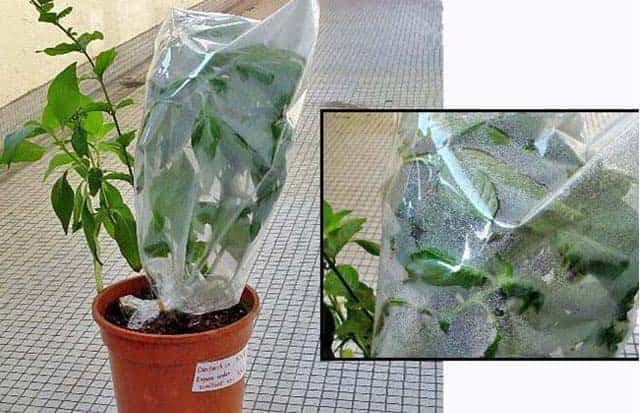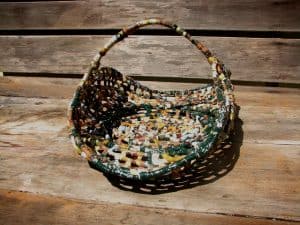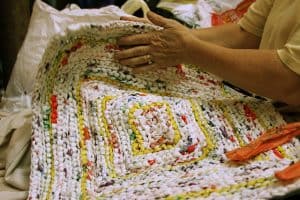Every year, about 500 million to 1 trillion plastic shopping bags are used each year. You can find them all over the place, from stuck in trees in the cities or along the banks of riverbeds.
Normally, all these plastic bags are a major eyesore. However, in a survival situation, you’ll be really glad that there are plastic shopping bags all over the place – and that you know these 9 awesome survival uses for them.
1. Collect Water from Plants through Transpiration

If you are out in the wild and can’t find any water, you can collect the water which naturally comes off of trees, bushes, and other plant life. This is known as “transpiration.”
All you need to do is tie a plastic bag around a bunch of greenery, making sure that a corner of the bag is angled downwards.
As the plant releases its water into the air, it will collect in the bag as condensation. The droplets of condensation will drip down into the corner of the bag.
Transpiration works best with clear plastic bags, and it also helps to have a lot of sun beating down on the bag. It will take a while (about an entire day) and you won’t get much water. However, this little bit of water can be enough to save your life.
The more plastic bags you have to tie to plants, the more water you will collect. Read more about transpiration and ways to find water in survival situations.
2. Make a Rope
One plastic bag by itself isn’t very strong. However, when you braid strips of plastic bags together, you can form a very strong rope.
There is virtually no limit to what you can do with a rope in SHTF situations.
Read about survival uses for rope.
3. Weave Supplies
Just like how you can braid strips of plastic shopping bags into a rope, you can also use those strips to weave supplies you need.
You’ll need to know how to weave/knit in order to do this, so now is a good time to start practicing. Check out these photos of cool things made from woven plastic bags.


4. Catch a Fish
To use a plastic bag to catch a fish, you must:
- Find a part of a stream/river/etc which has a narrow area
- Get lots of large rocks and construct a causeway in that narrow area. Basically, you are building a funnel for the fish to go down. At the end of the causeway, there needs to be a little gap.
- Put a net at the bottom of the causeway. You can make a net out of braided plastic bags. Or you can just use a doubled plastic bag. If you do this, you’ll need to poke very tiny holes in the bags so water can flow through, but make sure the holes aren’t so big that the bag will tear.
- Make sure your net/bags are anchored down well. The net/bags also need to be open so fish will get inside them.
- Go upstream and start scaring the fish towards the causeway. You can do this by throwing rocks into the water.
- The fish will swim into the causeway and be funneled into your net/bags.
Read more about how to make a survival fish trap without supplies here.
5. Conceal a Weapon
In a SHTF scenario, you need to have your weapon ready to go. But walking around with a knife or gun in your hand can also make you more of a target.
At Active Response Training, they give the good advice of putting your weapon in a dark-colored shopping bag.
No one will suspect that you’ve got a weapon in there, and you will be able to utilize your weapon really quickly.
6. Make Waterproof Fabric from Plastic Bags
Plastic shopping bags will melt if you apply heat to them. Using an iron, you can fuse shopping bags together to make a large piece of fabric, which can then be used in many ways.
These pictures show a raincoat which was made from fused plastic bags, but you could also fuse them together to make a tarp to use as a tent or for rainwater collection.
Watch the video below for instructions.
The only major downside is that you will have to have an iron to do this. In a pinch, you could heat up a flat rock and use it as an iron.

7. Improvised Glove
A plastic bag isn’t exactly going to replace nylon gloves for surgery, but they can be used as gloves in many situations. For example, if you need to pick up a dead rat to remove it, just put the plastic gloves over your hands first.
8. Keep Feet Dry
Your feet are crucial to your survival in SHTF situations. I’ve even made a point to pack extra wool socks in my Bug Out Bag (see a Bug Out Bag packing list here).
I know that if my feet get wet, I will get blisters and have a hard time walking to safety. Wet feet will also make it hard for you to stay warm.
If you are crossing a stream, you could put plastic bags around the outside of your shoes to keep your feet dry. But you can’t really keep the plastic bags on there because it would make it hard to walk (plus the bags would rip and tear quickly anyway).
Instead, put bags outside of your socks but inside your shoes. This will make a protective barrier to keep your feet dry after your shoes have gotten wet.
9. Emergency Toilet Liners
One thing that people commonly forget about in their disaster preparations is how will they go to the bathroom in SHTF situations.
The plumbing isn’t likely to be working after certain types of disasters, so you won’t be able to go in the toilet!
The easiest emergency toilet system is the two-bucket system. Use one bucket for pee, as pee doesn’t carry dangerous bacteria and pathogens so it can just be dumped outside. The other bucket is for poo. Line this bucket with plastic bags! After each use, dump a bit of sawdust, kitty litter, or torn-up newspaper into the poo bucket. At the end of each day or when it fills up, tie off the plastic bag and dispose of it safely.
Ideally you would want a sturdier plastic bag for your emergency toilet but those shopping bags will do in a pinch.



I use them in my van as little trash bags or on the go, for separating dry stuff from wet stuff, clean from dirty etcetera. It’s not the ideal (tissue or even unprinted! paper is better) but they can also be used for foraging herbs and mushrooms.
always great information I love plastic bags, i save the good ones -ones with a hole i donate to who ever wants them.
We make mats for the bags that we get from others. Most of them end up going overseas to various Heathcare Facilities where they are used as a sterile surface in surgeries and other treatment practice. (The mats are readily returned to a sterile condition by soaking in a bleach solution and can be reused many times.)
The remaining mats end up at local shelters and are distributed there.
That is really cool!
Very useful, as all in primal survival
Don’t you mean put the bags outside your socks and then inside your shoes???
Growing up in Minnesota, we put bread bags over our socks and then inside our boots to keep our feet dry
That’s exactly what the article says if you keep reading 🙂
Very good ideas! I have made mats for homeless people from plastic bags. Presently I am working on a cap which is made from plastic bags
At least here in S. California, some of the bags the stores are using now (because of the pandemic), are very thick and sturdy, and fit perfectly in a 5-gallon bucket. A perfect use for an emergency toilet.
If you are going to use bags for your poo bucket, you want to make sure those bags don’t have little holes in them. Some do, to prevent kids suffocating if they put them over their heads.
Yep – double bagging should help with this.